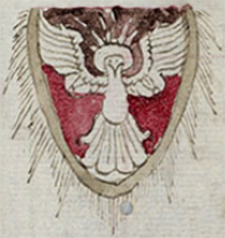espíritu santo (CST31)
This painting of the simplex glyph for the term espíritu santo (Holy Spirit or Holy Ghost, a loanword that entered Nahuatl from Spanish, with an ultimate origin in Latin), shows a painting of this religious figure on what seems to be a wall hanging. The spirit is a white bird with wings raised and tail feathers spread wide. The bird has a kind of halo or crown with rays coming up from the top. The background has two colors, purple in the top half and red at the bottom. Thread-like rays come out all around from the border or the cloth (except the top), seemingly conveying a radiance that has a sacred or divine effect. The companion text says that this purchase and others were necessary for Pentecost.
Stephanie Wood
For more on the Codex Sierra, see Kevin Terraciano’s study (2021), especially pp. 119 and 154 for the transcription and translation of the companion text. Another Holy Spirit appears on plate 25 (see below). In the broader collection, birds are typically shown in profile, and even when their wings are in use, they are not shown in a frontal open spread position. We do have some insects and bats in this collection that are presented with wings spread open.
Stephanie Wood
1550–1564
Jeff Haskett-Wood
religión, espiritus, religión católica, palomas, rayos, coronas, feathers, ave, aves, pájaro, pájaros, pluma, plumas, animals, animales

espiritu santo, Holy Ghost or Holy Spirit, https://nahuatl.wired-humanities.org/content/espiritu
espíritu santo
Stephanie Wood
Códice Sierra-Texupan, plate 31, page dated 1560. Origin: Santa Catalina Texupan, Mixteca Alta, State of Oaxaca. Kevin Terraciano has published an outstanding study of this manuscript (Codex Sierra, 2021), and in his book he refers to alphabetic and “pictorial” writing, not hieroglyphic writing. We are still counting some of the imagery from this source as hieroglyphic writing, but we are also including examples of “iconography” where the images verge on European style illustrations or scenes showing activities. We have this iconography category so that such images can be fruitfully compared with hieroglyphs. Hieroglyphic writing was evolving as a result of the influence of European illustrations, and even alphabetic writing impacted it.
https://bidilaf.buap.mx/objeto.xql?id=48281&busqueda=Texupan&action=search
The Biblioteca Digital Lafragua of the Biblioteca Histórica José María Lafragua in Puebla, Mexico, publishes this Códice Sierra-Texupan, 1550–1564 (62pp., 30.7 x 21.8 cm.), referring to it as being in the “Public Domain.” This image is published here under a Creative Commons license, asking that you cite the Biblioteca Digital Lafragua and this Visual Lexicon of Aztec Hieroglyphs.







